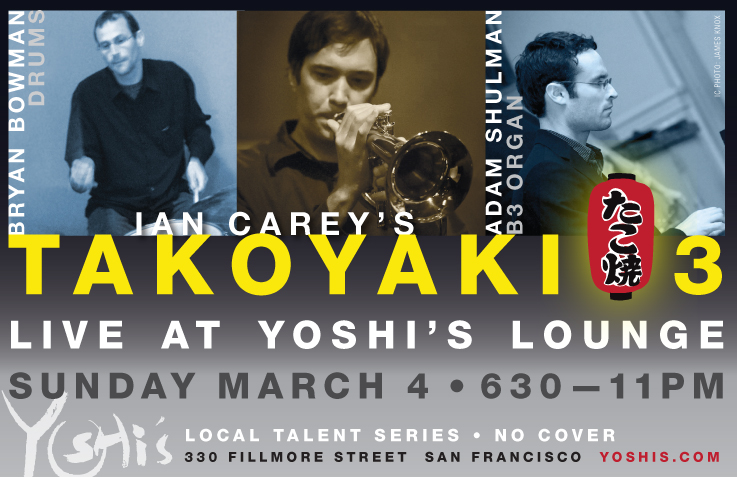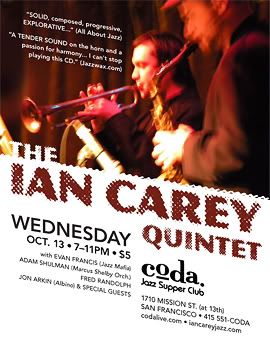Happy New Year! (You can thank me later for not saying "jazzy.") Lots going on, so here goes:Here Comes Duocracy!Duocracy, my soon-to-be-released duo album with my good friend pianist Ben Stolorow, is being pressed as we speak! (You can read a lot more about the album here: Ian Carey, Ben Stolorow, and Duocracy.) Ben and I are currently gearing up for our two CD release shows:
- East Bay: Friday, February 21 at The Jazzschool in Berkeley
- North Bay: Friday, March 7 at Old St. Hilary's in Tiburon
If you're not going to be able to make either of those, we're also playing a private preview show in Richmond on the afternoon of January 20 (MLK Day)--email me (ian [AT] iancareyjazz.com) if you're interested in attending.Winter CircusLater this month, I'm happy to be involved in a rare off-season performance with the great Circus Bella, featuring outstanding original music by accordionist/keyboardist/guitarist/composer/"Nice Guy" Rob Reich, with the Circus Bella All-Star Band (with Rob, Greg Stephens on trombone, Ralph Carney on a potpurri of woodwinds & sundries, Michael Pinkham on drums, & me on trumpet). We'll be doing two shows on Saturday, January 26 at the Jewish Community Center in San Francisco. Last chance to see us before summertime!New to Me: Arranger EditionYou may remember I have a periodic series of posts about standout albums which, while not necessarily new to the world, are new to me. As I'm about to get to work on a new, extended composition for my Quintet+1 (funded by a generous grant from the San Francisco Friends of Chamber Music's Musical Grant Program—you should apply too!), which will be premiered this fall, I've been spending a lot of time seeking out new-to-me recordings by great arrangers and composers in order to help get my creative wheels turning. Here are a few: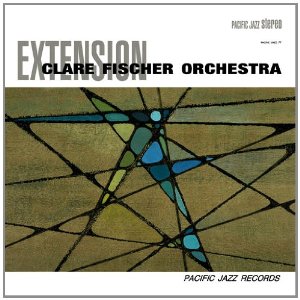 Clare Fischer Orchestra: Extension (1963) Ever run into one of those records where you know almost immediately it's going to be one of your all-time favorites? This one, which I picked up at a record store in San Rafael (along with some other finds including albums by Martial Solal & Don Cherry) was one of those records. Fischer, a burning pianist, has been featured in "New to Me" before, but this was my first time checking out his larger ensemble work. I remember Mike Mossman talking up Fischer's charts in an arranging class, and I can see why--tons of counterpoint, dense but beautiful harmonic language--all delivered without the use of trumpets, which serves the dual purpose of letting his phenomenal woodwind writing shine (lots of flute/clarinet lead) while keeping it away from that stereotypical "big band" sound that is so hard to avoid (no matter how hip the writing). Plus it swings, with some nice blowing by Fischer and the Warne-esque Jerry Coker. It's even got a Passacaglia, which is one of my favorite musical forms! Highly recommended. (P.S. Marc Myers did a great write-up about this album when it was reissued--check it out.) Buy here.
Clare Fischer Orchestra: Extension (1963) Ever run into one of those records where you know almost immediately it's going to be one of your all-time favorites? This one, which I picked up at a record store in San Rafael (along with some other finds including albums by Martial Solal & Don Cherry) was one of those records. Fischer, a burning pianist, has been featured in "New to Me" before, but this was my first time checking out his larger ensemble work. I remember Mike Mossman talking up Fischer's charts in an arranging class, and I can see why--tons of counterpoint, dense but beautiful harmonic language--all delivered without the use of trumpets, which serves the dual purpose of letting his phenomenal woodwind writing shine (lots of flute/clarinet lead) while keeping it away from that stereotypical "big band" sound that is so hard to avoid (no matter how hip the writing). Plus it swings, with some nice blowing by Fischer and the Warne-esque Jerry Coker. It's even got a Passacaglia, which is one of my favorite musical forms! Highly recommended. (P.S. Marc Myers did a great write-up about this album when it was reissued--check it out.) Buy here.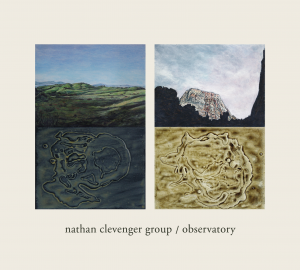 Nathan Clevenger: Observatory (2013) Nathan & I run in a lot of the same circles (this album features my longtime collabo-friends Kasey Knudsen, Jon Arkin & Evan Francis, for example) and the frequency at which he can find opportunities to perform music like this with a band this size is nothing short of amazing. (With any luck we may have a double-bill in the future.) A great balance of inspiring blowing & thorny writing, tunes with surprising arcs (see "Sleepwalker's Anecdote"), and more bass clarinet than you can shake a stick at. I don't think it's too presumptuous to say I think Charles Mingus would like this record. Buy here. Speaking of Mingus:
Nathan Clevenger: Observatory (2013) Nathan & I run in a lot of the same circles (this album features my longtime collabo-friends Kasey Knudsen, Jon Arkin & Evan Francis, for example) and the frequency at which he can find opportunities to perform music like this with a band this size is nothing short of amazing. (With any luck we may have a double-bill in the future.) A great balance of inspiring blowing & thorny writing, tunes with surprising arcs (see "Sleepwalker's Anecdote"), and more bass clarinet than you can shake a stick at. I don't think it's too presumptuous to say I think Charles Mingus would like this record. Buy here. Speaking of Mingus: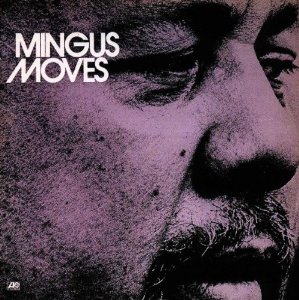 Charles Mingus: Mingus Moves (1973) This is one I somehow never got around to hearing until recently. Not everything here is my cup of tea (the singers and trumpet player, for example) but "Canon" is classic, and Sy Johnson's chart on "Wee" makes the trip worthwhile. Plus prime George Adams & Don Pullen, and of course the great Dannie Richmond & the man himself. Buy here.
Charles Mingus: Mingus Moves (1973) This is one I somehow never got around to hearing until recently. Not everything here is my cup of tea (the singers and trumpet player, for example) but "Canon" is classic, and Sy Johnson's chart on "Wee" makes the trip worthwhile. Plus prime George Adams & Don Pullen, and of course the great Dannie Richmond & the man himself. Buy here.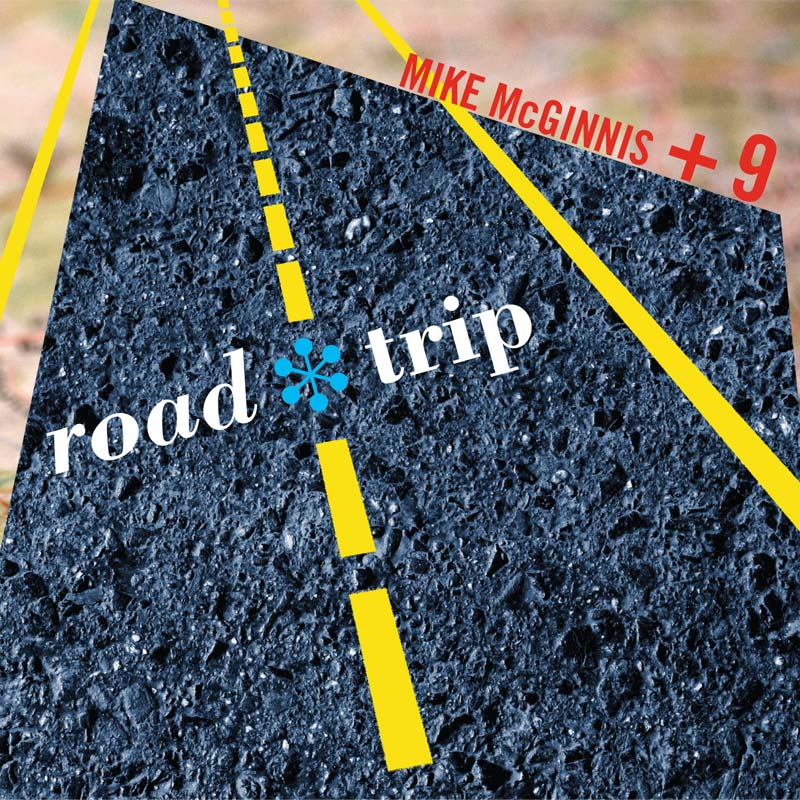 Michael McGinnis+9: Road*Trip (2013) I played with Mike a few times when I lived in NYC and we had a lot of friends in common. This album features a great new recording of Bill Smith's Third-Stream masterpiece Concerto for Clarinet & Jazz Combo--which is worth the price of admission by itself--but definitely stick around for McGinnis's extremely interesting title suite, which brings the Third Stream vibe into the present. The first movement is a personal favorite. Buy here.
Michael McGinnis+9: Road*Trip (2013) I played with Mike a few times when I lived in NYC and we had a lot of friends in common. This album features a great new recording of Bill Smith's Third-Stream masterpiece Concerto for Clarinet & Jazz Combo--which is worth the price of admission by itself--but definitely stick around for McGinnis's extremely interesting title suite, which brings the Third Stream vibe into the present. The first movement is a personal favorite. Buy here.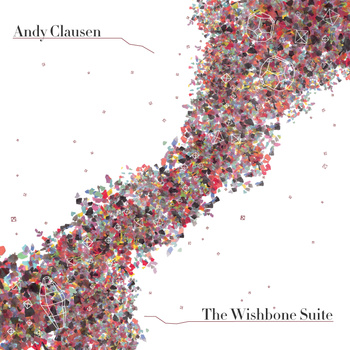 Andy Clausen: The Wishbone Suite (2012) Man, has this guy got compositional chops to burn. In addition to having no problem "putting the notes on the paper," Clausen brings an impressive amount of variety, with pieces ranging from hypercomposed and intricate to sections of open freeish blowing (I think)--I especially love the frequent lack of obvious lines where the improvisation begins and ends, which loosens up some very in-depth writing (something I've been working on in my own music). The interesting instrumentation (trombone, clarinet, piano, accordion, percussion) adds an extra layer of cohesion. Buy here.
Andy Clausen: The Wishbone Suite (2012) Man, has this guy got compositional chops to burn. In addition to having no problem "putting the notes on the paper," Clausen brings an impressive amount of variety, with pieces ranging from hypercomposed and intricate to sections of open freeish blowing (I think)--I especially love the frequent lack of obvious lines where the improvisation begins and ends, which loosens up some very in-depth writing (something I've been working on in my own music). The interesting instrumentation (trombone, clarinet, piano, accordion, percussion) adds an extra layer of cohesion. Buy here.
